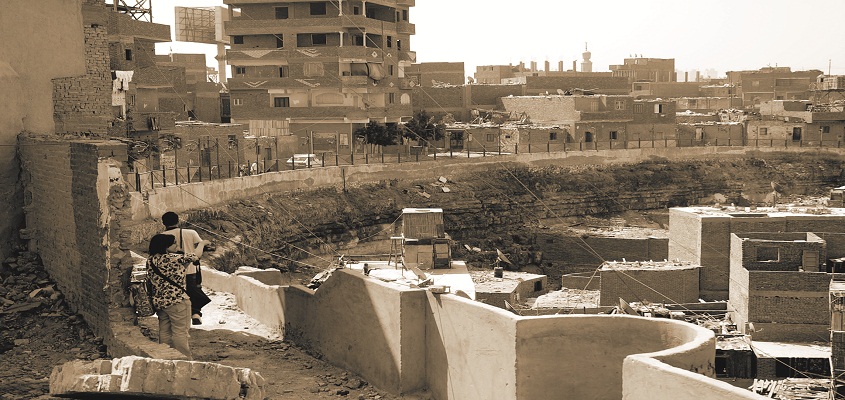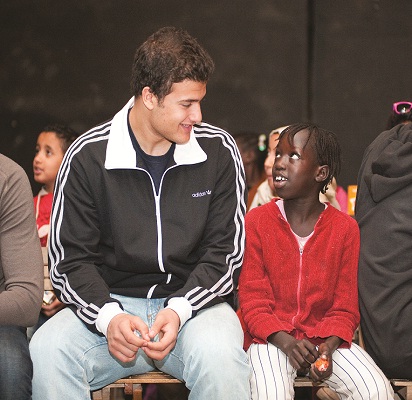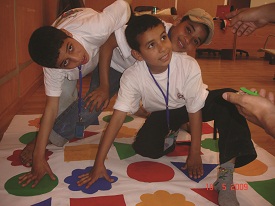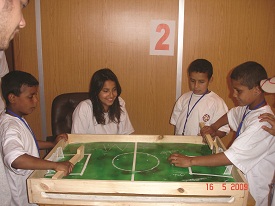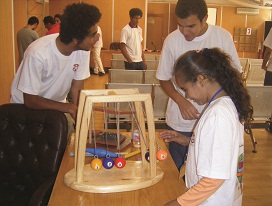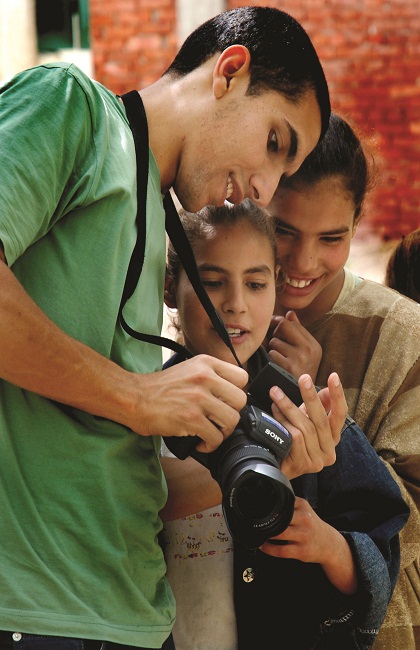|
||||||||||||||||||||||||||
| Students docuemnt preparations for the forced removal of residents of Establ Antar, neccessitated by the need to move houses away from the edge of hillside areas due to fear of rock slides | ||||||||||||||||||||||||||
For the children in Establ Antar, a community located in Cairo’s Fustat suburb, piles of garbage loom everywhere. The trash has become the backdrop against which these children sit and play. Rummaging through the rubbish has become a game, made all the more fascinating by the children’s search for small scorpions that live among these piles, holding them out to their friends when they are able to catch one. With no toys or games to play with, finding these venomous creatures with powerful stings has become the children’s primary form of entertainment. Pairing with the community school at Establ Antar, AUC students in the Introduction to Engineering course were set to design toys that would curb the children’s dangerous habit of chasing after scorpions. At the beginning of the course, students sketched and analyzed specific design features for different toys and games. Mid-semester, the students visited the children at Establ Antar and worked with them to identify their likes and dislikes and brainstorm ideas for their projects. The students then designed products, such as scooters and airplanes, for the children, who were invited to the AUC campus to test the toys and vote for their favorite. “The students began to take on mentorship roles with the kids,” said Lamyaa El Gabry, assistant professor of mechanical engineering and course instructor. “This project raised their awareness about their ethical and social obligation as engineers. It also helped them develop their problemsolving skills using engineering principles and practice.”
El-Gabry’s introductory engineering class is one of many community-based learning (CBL) courses at AUC, whereby students engage in service activities as part of their academic curricula. CBL started in 2001, when an AUC task force traveled to Harvard, Brown, Georgetown and other prominent U.S. universities to collect information on community-service initiatives and recommended blending community service with academic courses. Although CBL has been practiced for years at AUC, the program was recently institutionalized through the university’s John D. Gerhart Center for Philanthropy and Civic Engagement and the Center for Learning and Teaching. This has allowed the program to expand, reaching almost 50 classes, and increased the university’s networking opportunities with non governmental organizations. It has also provided a structure to document and evaluate the impact of the CBL curricula on students, in addition to providing resources and training to faculty members. From engineering and mass communication to rhetoric and composition classes, CBL covers a wide range of academic disciplines and aims to enhance student learning of participatory development. “We use the term community-based learning to describe an approach that recognizes the reciprocal value of working in partnership with communities,” said Amani Elshimi, director of CBL and senior instructor of rhetoric and composition who has been using the method in her own classes for more than eight years. “Students enhance the specific learning outcomes of a course through delivering a service, defined and evaluated by the community. They expand course-related knowledge and develop the skills of problem solving, critical and creative thinking, communication and teamwork. The communities benefit from student expertise, skills and creative energy. The relationship is not hierarchical with privileged students from an elite institution helping a disadvantaged community. Rather, it is a partnership of shared power, benefit and resources.” Aware of the limitations of the program, she added, “We are not changing economic levels or physical And that’s what students value about the courses. As Saher Quebeisi, a construction engineering senior who was one of El-Gabry’s students, noted, “It was an amazing experience that I will never forget. I really want to visit these children again. One of them told me that he made a frame for the design I drew and put it in his home. I was really touched.”
Students in Brooke Comer’s Research Writing class echoed the same sentiment. Comer, who teaches rhetoric and composition, has connected her students with Sudanese AUC photo-ethnography student shares images and provides photography instruction to children living on the Magdy Farm near Ismailia Robert L. Jones, II 35 refugees in Egypt for the past two years. Aiming to raise awareness about the plight of these refugees, the class met with them on a weekly basis to compile narratives of their daily lives and unique struggles. In the end, the interviews were published in a book, Voices in Refuge: Stories from Sudanese Refugees in Cairo (AUC Press, 2009), edited by Comer, Elshimi and Nora El Tahawy ’07, one of Elshimi’s former students. The students also produced short skits on thematic issues such as tolerance and acceptance, the proliferation of gangs and violence, and human rights. “I honestly did not know anything about Sudanese refugees before I took this class,” explained Aya El-Kolaly, a journalism and mass communication major. “I suggest that other students take these types of classes and get involved because I know they will appreciate the experience the same way I have.” Nora El Sadat, a journalism and mass communication senior who has been participating in the workshops since she enrolled in Comer’s class two years ago, added, “I love seeing them smile, knowing that they lead difficult lives and this is an opportunity for them to enjoy themselves. At first, I approached this as a necessary component of the course, but when the class ended I could not let go. After two years, everyone knows me. We’ve bonded.” Beyond enhancing their research and writing skills, the course benefited the students on a personal level. “In our interactions with refugee children and adults, the students forged relationships that transcend class barriers,” explained Comer. “They discovered that a number of young refugees come from backgrounds much like their own –– children of prosperous merchants and large landowners, disenfranchised by war and forced to live in poverty. In discovering who these refugees really are, the students came to realize their own power in terms of the responsibility they possess and that social justice is determined in some small part by the role they play. Their understanding is not limited to refugees because the students also learned something about themselves.”
Whereas Comer’s class used writing to document the lives of refugees, students in Robert Jones’s visual communication and photography classes used ethnographic photography techniques to chronicle the lives of underprivileged communities while training local residents on how to create their own visual and aural histories. Collaborating with an Italian non-governmental organization, Live in Slums, the class is helping the NGO in its production of a documentary, as well as photographs and stories, that explore the lives of inhabitants in the City of the Dead. For Tawasol and the Association for the Protection of the Environment, two Egyptian NGOs, AUC students documented life in Establ Antar and Manshiet Nasser through photography, ultimately designing a craft revival catalog, as well as calendars and brochures, and holding photography exhibitions to help showcase traditional Egyptian arts and crafts, their history and the artisans themselves. They also trained community residents in camera work and video shooting. “Our goal was to give residents the tools and the skills they need to have the representation of their community drawn from within it,” explained Jones, professor of practice at the journalism and mass communication department. He added that the Italian NGO is in the process of building a Community Reference Laboratory, including a photo studio and sound stage, that will be the host for photography exhibitions as well as related storytelling projects and activities based on the students’ work. “Through this photo-ethnography project, the students have developed impressive bodies of visual knowledge about Egyptian culture that some may have taken for granted or underestimated in terms of intrinsic cultural value,” Jones said. The students also worked in conjunction with the United Nations Population Fund to develop posters and stories in order to raise public awareness of many social issues like female genital mutilation, family planning, and violence against women and children. In addition, they worked closely with Markaz Crafts Revival and Development Center to photograph traditional crafts made by Bedouin women. The pictures were then used in brochures, calendars, T-shirts and other products to promote the women’s work. “We were working to help these communities empower themselves by raising demand for their products, and at the same time, we enhanced our photography skills,” explained Mariam Labib ’10, one of Jones’s former students. “It was truly a reciprocal and gratifying experience.” |
||||||||||||||||||||||||||
